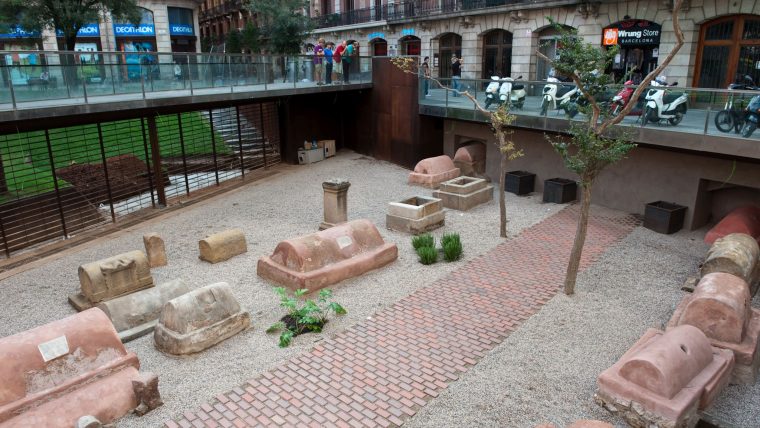MUHBA's Roman Sepulchral Way

Funeral monuments from the Ancient Roman city of Barcino survive on the Roman Sepulchral Way, in Plaça de la Vila de Madrid.
Between the 1st and 3rd centuries BC, many lower and middle-class citizens of the Roman city of Barcino were buried on either side of a road that led from the colony to the present-day area of Sarrià. Some of these funeral monuments still survive on the Roman Sepulchral Way, in Plaça de la Vila de Madrid.
Altar stones, stelas and cupae, semi-circular monuments, remained hidden for centuries under a Barefoot Carmelite convent, until the necropolis was discovered at the end of the 1940s, when the square was undergoing redevelopment.
There is an Interpretation Centre next to the archaeological site, where the artefacts found there are exhibited and the territorial layout of Barcino and the complex world of Roman funerals are explained.
Take a look at the offers available to members of the Gaudir Més programme.
 :
:
- Titularity:
- Public center
-
Itinerari 'Barcino/BCN'
- When:
- From 13/10/2024 to 15/12/2024
Schedule
| Days | Hours | Preus | ||
|---|---|---|---|---|
|
Dimarts |
d'11:00 h a 14:00 h |
Entrada general: 2 €
Entrada reduïda: 1,5 €, . menors de 29 anys . majors de 65 anys . carnet de biblioteques de Barcelona . targeta rosa reduïda . carnet de família nombrosa . carnet de família monoparental . grups superiors a 10 persones
Entrada gratuïta: . menors de 16 anys . targeta rosa gratuïta . membres de l’ICOM . Barcelona Card . Associacions Museòlegs de Catalunya . passi metropolità d'acompanyant d'una persona amb discapacitat, . promoció 'Gaudir +' . primer diumenge de mes tot el dia . diumenges a partir de les 15:00 h. . 11 de febrer (Santa Eulàlia) . 22 i 24 de setembre (La Mercè) |
||
|
Diumenge i festius Tancat 25 de desembre 1 de gener 1 de maig 24 de juny |
d'11.00 h a 15.00 h i
de 16.00 h a 19.00 h |
|||
|
Nit dels Museus 2024: 18 de maig |
de 19.00 h a 01.00 h |
Entrada Gratuïta |
La Via Sepulcral Romana que es troba a l´actual Plaça de la Vila de Madrid, correspon a un vial secundari que comunicava la colònia Barcino amb l´actual zona de Sarrià. La via arribava a la porta sud del cardo maximus i a ambdós costats de la mateixa es localitzaven els diferents monuments funeraris: ares, esteles i especialment cupes, uns monuments semicirculars que recorden una bóta de fusta. La zona funerària va estar en ús entre els segles I-III de la nostra era, i va quedar totalment colgada amb el pas dels temps i les constants deposicions de riera, fet que va facilitar la seva conservació. Al costat de l´àrea arqueològica, s´ubica un Centre d´Interpretació on s´hi poden veure els objectes trobats al jaciment, i on s´explica l´organització del territori de Barcino, la centuriació, les vies, els camins i també el complex món funerari romà, a través dels diferents ritus documentats a la necròpolis.
- Address:
- Plaça de la Vila de Madrid, 1
- District:
- Ciutat Vella
- Neighborhood:
- el Barri Gòtic
- City:
- Barcelona

